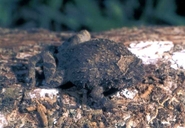|
Description
F 28 mm. Tympanum indistinct, about 3/4 of eye diameter. Traces of webbing between fingers and toes. Tibiotarsal articulation reaches the tympanum. Finger 2 slightly longer than finger 4. Skin on the back granular. Dorsu light brown (Glaw and Vences 2007).
Similar species: R. testudo has barbels on the lower lip (Glaw and Vences 2007).
Distribution and Habitat
Country distribution from AmphibiaWeb's database: Madagascar
Occurs in Betampona, Marojejy, Masoala (Glaw and Vences 2007) at approximately 200-1000m asl (Andreone and Raxworthy 2008).
Life History, Abundance, Activity, and Special Behaviors
Habits: Fossorial and terrestrial, in rainforest, poorly known (Glaw and Vences 2007).
Trends and Threats
This species is listed as vulnerable because its extent of occurrence is less than 20,000 km2, its distribution is severely fragmented, and there is continuing decline in the extent and quality of its forest habitat in northeastern and eastern Madagascar (Andreone and Raxworthy 2008). It occurs in the Réserve Naturelle Intégrale de Betampona and Parc National de Marojejy, and probably in Parc National de Masoala and Parc National de Mananara Nord (Andreone and Raxworthy 2008). Its forest habitat is receding due to subsistence agriculture (including livestock grazing), timber extraction, charcoal manufacture, the spread of invasive eucalyptus, and expanding human settlements. The coastal rainforest is under particularly serious pressure as a result of human activities (Andreone and Raxworthy 2008). Possible reasons for amphibian decline General habitat alteration and loss
Habitat modification from deforestation, or logging related activities
Intensified agriculture or grazing
Urbanization
Comments
Taken with permission from Glaw and Vences (2007) and Andreone and Raxworthy (2008).
References
Andreone, F. and Raxworthy, C. (2008). Rhombophryne coudreaui. In: IUCN 2008. 2008 IUCN Red List of Threatened Species. www.iucnredlist.org. Downloaded on 14 April 2009.
Glaw, F., and Vences, M. (2007). Field Guide to the Amphibians and Reptiles of Madagascar. Third Edition. Vences and Glaw Verlag, Köln.
Originally submitted by: Miguel Vences and Frank Glaw (first posted 2001-10-26)
Edited by: Catherine Aguilar (2010-07-19)Species Account Citation: AmphibiaWeb 2010 Rhombophryne coudreaui <https://amphibiaweb.org/species/2349> University of California, Berkeley, CA, USA. Accessed Nov 22, 2024.
Feedback or comments about this page.
Citation: AmphibiaWeb. 2024. <https://amphibiaweb.org> University of California, Berkeley, CA, USA. Accessed 22 Nov 2024.
AmphibiaWeb's policy on data use.
| 



 Map of Life
Map of Life